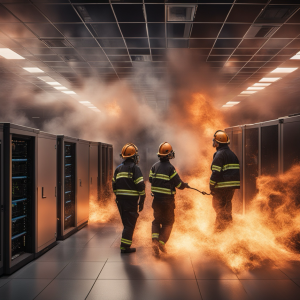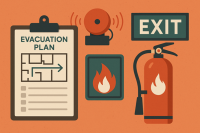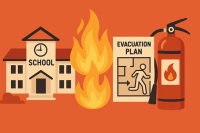
In an increasingly digital world, data centers have become the backbone of nearly every industry—from finance and healthcare to e-commerce and entertainment. These high-density hubs of information storage and processing are mission-critical assets. Yet, they face a range of threats, and one of the most devastating is fire. The consequences of a fire in a data center can be catastrophic: data loss, downtime, equipment damage, reputational harm, and massive financial loss. Therefore, effective fire protection strategies are not just an operational necessity but a business imperative.
This article explores the unique challenges of fire protection in data centers and outlines state-of-the-art solutions used to mitigate the risks.
The Unique Fire Risks in Data Centers
- High Power Density
Modern data centers house rows of servers, power distribution units (PDUs), and cooling infrastructure—all packed tightly into relatively small areas. These systems consume vast amounts of electricity, making them prone to electrical faults, overheating, and arc flashes, which are common causes of fire. - Continuous Operation Requirements
Unlike typical commercial buildings, data centers are designed to operate 24/7. Shutting down for fire maintenance or retrofitting can cause unacceptable disruption. This poses a major constraint when installing or upgrading fire protection systems. - Sensitive Equipment
The equipment housed within data centers—servers, routers, switches, and storage arrays—is highly sensitive to moisture and corrosive chemicals. Traditional fire suppression systems like water sprinklers are inappropriate, as they may extinguish a fire but destroy the very assets they aim to protect. - Rapid Fire Spread Potential
Due to the high airflow required for cooling and the presence of combustible materials (cable insulation, plastics, etc.), a small ignition event can escalate quickly if not detected and suppressed immediately.
Key Components of Data Center Fire Protection
Effective fire protection in data centers typically involves a multi-layered approach composed of the following systems:
- Fire Prevention
Preventative measures are the first line of defense:- Good cable management and regular inspection reduce the risk of overheating and arc faults.
- Proper HVAC maintenance ensures that heat and airflow are controlled efficiently.
- Thermal monitoring systems help identify hot spots before they lead to ignition.
- Early Detection Systems
Speed is critical when detecting a fire in a data center. Conventional smoke detectors often react too slowly.- Very Early Smoke Detection Apparatus (VESDA): These systems continuously sample air and can detect minute particles of combustion well before smoke is visible.
- Multi-sensor detection systems combine heat, smoke, and gas sensors for greater accuracy and fewer false alarms.
- Fire Containment and Suppression
Once a fire is detected, suppression must be rapid and non-damaging:- Clean Agent Fire Suppression Systems: Gases such as FM-200, Novec 1230, or inert gases (like nitrogen and argon blends) are commonly used. They displace oxygen or interrupt the chemical reaction of combustion without harming equipment.
- Water Mist Systems: For some zones, ultra-fine water mist systems can suppress fire using minimal water, reducing the risk of water damage.
- Pre-Action Sprinkler Systems: These systems require two triggers (e.g., heat and smoke detection) to activate, reducing the chance of accidental discharge. They are often used as a backup layer.
- Compartmentalization
Dividing a data center into fire-resistant compartments can limit the spread of fire. Fire-rated walls, ceilings, and cable penetrations help contain fires and allow more targeted suppression responses.
Challenges in Implementing Fire Protection in Data Centers
- Retrofitting Legacy Systems
Older data centers may not be built with fire protection in mind. Upgrading these facilities to modern standards can be costly and disruptive. - Balancing Protection with Uptime
Any installation or maintenance procedure that interrupts services is a major concern. Designing systems that are effective yet minimally invasive is a constant challenge. - False Alarms and Nuisance Triggers
Overly sensitive systems may cause false alarms, leading to unnecessary evacuation or suppression system activation—both of which can result in downtime and equipment risk. - Regulatory Compliance
Data centers must comply with national and international fire codes (e.g., NFPA 75, NFPA 76, EN 50600). These regulations evolve over time and may vary by jurisdiction, requiring constant vigilance. - Environmental and Sustainability Concerns
Some suppression agents have a high global warming potential (GWP) and are being phased out under environmental regulations. Transitioning to eco-friendly alternatives without compromising effectiveness is a growing concern.
Emerging Solutions and Innovations
- AI and Predictive Analytics
Artificial intelligence can monitor environmental data and predict overheating or fire risks before they materialize. This allows for proactive maintenance and incident prevention. - Modular Fire Protection Units
Prefabricated modular data centers with built-in fire protection systems are gaining popularity for their rapid deployment and consistent design standards. - Hybrid Suppression Systems<
Combining multiple suppression methods (e.g., clean agent plus water mist) can provide more comprehensive coverage while minimizing trade-offs. - Remote Monitoring and IoT Integration
Fire protection systems can now be integrated with broader building management platforms. This allows for centralized monitoring, real-time alerts, and remote response capabilities.
Best Practices for Fire Protection Strategy
- Conduct comprehensive risk assessments and review them regularly.
- Use redundant detection systems to ensure reliability.
- Establish clear fire response protocols and training for all staff.
- Maintain adequate insurance coverage and disaster recovery plans.
- Perform regular testing and maintenance of all fire protection systems.
Conclusion
Fire protection in data centers is a complex, high-stakes endeavor that requires specialized knowledge, forward-thinking design, and rigorous execution. As technology continues to evolve and the demand for data grows, so too must our methods for safeguarding it. By addressing the unique challenges of data centers and implementing multi-tiered, innovative solutions, operators can ensure resilience, minimize risk, and protect what is now one of the most valuable assets in the modern economy: data.





Leave A Comment